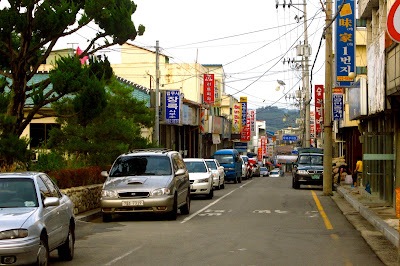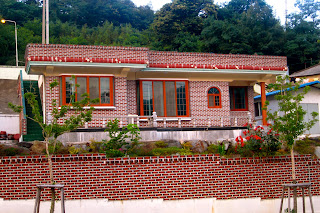If you’ve tracked my time in Korea at all in the past
11 months or so, it goes without saying that you’ve seen pictures of adorable
kids, beautiful old palaces, beaches, and mountains, and markets that will,
without a doubt, test all of the 5 senses.
Though I’ve photographed and defined a number of things about my life,
it’s high time I actually show you around the town in which I live. These next posts will seek to do just that—show
you how these people live, and how I’ve come to live like that.
Hampyeong (함평) has been
my home for almost a year now. Here’s a
quick map, just to get you situated, before I throw some numbers at you.
At the time of the last census, Hampyeong was roughly 393 square
kilometers, or 152 square miles (for those of you playing at home, let’s call
it the size of Minneapolis and St. Paul city limits put together). Traveling end to end, north to south, east to
west, would take the average county bus around 30-45 minutes. As of 2001, the population was 45,232, though
all of us can attest to significant growth in the last several years
alone. There are 11 elementary schools
(at 5 of which I teach), another 7 middle schools, and 4 high schools.
(Photo Credit: Erin Stieler)
To summarize as best I can about these generally smaller towns that find themselves as central hubs of much smaller countryside villages...from afar (and I mean driving into, hiking up on a hill to gaze down upon, etc.), they look like beautiful rural oases. Up close, however, you see a different place. A place that still tries deeply to reconcile old and new. A place that, small as it is, struggles to keep itself clean, outside of the fresh air. A place that, as of late, smells almost exclusively of onions.
A stroll down one of Hampyeong's several main streets, heading west to east.
It's always important to remember just how quickly Korea is growing and changing, and exactly where it was not so long ago. Once upon a time, Hampyeong was probably little more than agricultural fields with scattered hanoks (Korean traditional houses). Some time later, much of Hampyeong itself was run over by Korean War participants. To this day, much of the town looks just as it could've several decades ago--in some areas, electricity and running water appear to be the only modern features of lifestyle. In other areas, apartments are stacked upon one another, creating that classic Asian concept of sacrifice for a slightly more cramped living with the reward being more room to roam.
It's always easy to know when you're approaching a school zone, as the road tends to narrow, the hill tends to climb, and the houses get a bit more sparse and classical looking.
Though I can't say for sure about the housing demographics within town limits, it's fair to say that there are only a few apartments of the high-rise variety. This means, more or less, that many people live in individual houses (which, although small, probably offer more space than any apartment would). Of my students that live in town, I'd say half tend to live in apartments with their families up in the sky, and the other half live in individual brick or wooden houses amidst the streets. Another quick consideration about the living situation of many Koreans, especially in this more traditional region in which I live is this: as we all know, the importance of family is not lost on Asians, especially Koreans and, as such, multiple generations might live together. Many of my students, for example, live with grandparents, parents, and siblings. Some with just parents. Some with just grandparent(s). Some with none of the above. One general rule to use in deciding what, exactly, to make of home life in Korean is this: assume nothing, and don't pretend to know how it works and why.
You know you're starting to hit the outskirts of town when the farmland springs up; though Hampyeong is small, it's fair to say this is not downtown.
As you might have guessed already (and surmised about Korean from previous posts), much of urban Korea is surrounded by mountains on nearly every side, and Hampyeong is no exception to this. The town seems endlessly bounded by hills upon which one can climb and find a nice view of the area. The following picture is taken on a hill overlooking the valley immediately north of town, into which my bus descends every Tuesday, Wednesday, and Friday, bound for the more rural areas of Sonbul and Singwang.
As dusk, this is one of Hampyeong's best views
One can walk end to end of Hampyeong in about 20 minutes, no matter how you slice it. You start in a rice field, or a hillside vista overlooking various farms, and you end in a similar place. Let's say we turned around at this previous picture, heading south again back towards town. You drive along a wide street, bounded first by scattered churches, storage buildings, and stacks of every vegetable known to man. You begin to see colored rooftops, and that's when you know you're closer to town. You see the green road signs with their white and brown highlights (looks like home!), and you're back into civilization!
Here's one of the many main roads that connect the town of Hampyeong to the countryside.
Let's break this down: Muan (pronounced Moo-ahn), on the very top, is another county (like Hampyeong) about 10km to the southwest. Eomda (pronounced Uhm-dah) is one of several "myeon"s that comprise Hampyeong county--that is to say, it's within Hampyeong county limits, but smaller than the town of Hampyeong itself. Hampyeong Expo Parks also relatively straightforward--this is the big grounds for the annual Butterfly Festival. The county office and police station speak for themselves. And for you Americans, Asia's all about the meters.
...And we descend into Hampyeong.
Like I said, while many of those folks in the town of Hampyeong live in apartments, others opt for a more traditional house, usually made of wood or brick. Though the following picture probably won't mean much to you, this is a really nice house in Hampyeong. The nicely arranged brick, beautiful windows, and front wall/gate all set off the fact that whoever lives here lives in relative comfort.
Nice!
As I mentioned earlier, there are still plenty of hanoks (Korean traditional houses) in Hampyeong, scattered amidst the main streets and the miniature alleys. I can't say with any certainty if people actually live in these, or whether they're just for show. I have to be honest, though: when I was told I'd be living in the countryside, this is more or less what I had in mind. I'll take my apartment most days of the week, but some days I wish I'd been invited to stay in one of these.
Beautiful old hanoks at dusk
As Korean topography might frustrate the average foreigner and his or her knees and heels, Koreans have made the best of matters and stacked houses accordingly--the surest sign of a smaller town that's slightly bigger than some middle-of-nowhere village is this pattern of houses, stacked upon a hillside, all with their own architectural nuances--rooftops, color schemes, building materials, etc.
This sums it up well, especially the trailer of onions in front
Speaking of onions...they're everywhere
Lately, that last picture has been most reflective of Hampyeong and its agricultural pride. Vegetables line the street almost anywhere you go around town--onions, potatoes, and greens are dominating the market right now. Corn is also, surprisingly, ready to harvest these days (unlike at home, where it might need another month to turn especially delicious). Hampyeong doesn't thrive off of one vegetable alone, but you see more onions and radishes than anything--they're colorfully packaged, and placed in front of houses and businesses as almost more of a traffic barrier than a sign of good cuisine inside.
Here's another look at one of Hampyeong's main streets from the sidewalk in front of my apartment. A tangle of concrete buildings (everything from PC rooms to real estate to pizza to piano academies), electric wire, and people who, no matter how small and relaxed the town and its atmosphere have places to be, damnit.
My apartment lies on the very east side of town, about as far from the bus terminal, river, and any semblance of "downtown." Still, that's only about a 10-15 minute walk down a pleasantly quiet main street at most hours of the day. I'm thankful enough that going to sleep at night doesn't entail shutting every last crack of door and window in my humble abode--the elders and townspeople around me tend to call it a night long before I ever do, which probably helps. But in all seriousness, I didn't foresee getting a great night's sleep 9 times out of 10, undisturbed, with windows wide open in the summer months, in a place like Korea. Occasionally, you hear those raging drunk elders across the street, who hit the karaoke bar a little too hard, but that's not high on my list of complaints around here.
Here is my apartment building, Munseong Billa
A view from outside my kitchen window
To the best of my knowledge, there are exactly 5 schools wedged into the town limits--3 elementary schools, 1 middle school, and 1 high school. The following picture illustrates my end of town, bounded by (what else?) hills and mountains that keep out the majority of the sun in the morning hours. The landscaping is always impeccable, and these schools always seem to sit upon a hill that feels, in the wee hours of the day, damn near impossible to summit. Here is Hampyeong Elementary, my Thursday school, where I teach the best 5th graders you'll find in this country (I'm convinced).
Hampyeong Elementary in the fog (Photo Credit: Erin Stieler)
So there's a pretty solid opening statement about life around town. This is only a fraction of what you'd really see around town if you just open your eyes. If you walk off the beaten path (that is, the path of anyone under the age of about 70) around town or out in the countryside, you're in for some more subtle beauty and surprises, and that, my friends, will have to wait for the next post. Thanks for reading! I'll leave you with another great picture by Erin Stieler that will give you a nice little warm-up for countryside living.
Hampyeong countryside (Photo Credit: Erin Stieler)
And for anyone keeping track at home, I'm home in 28 days!
Love from the ROK,
-Sammy


















No comments:
Post a Comment